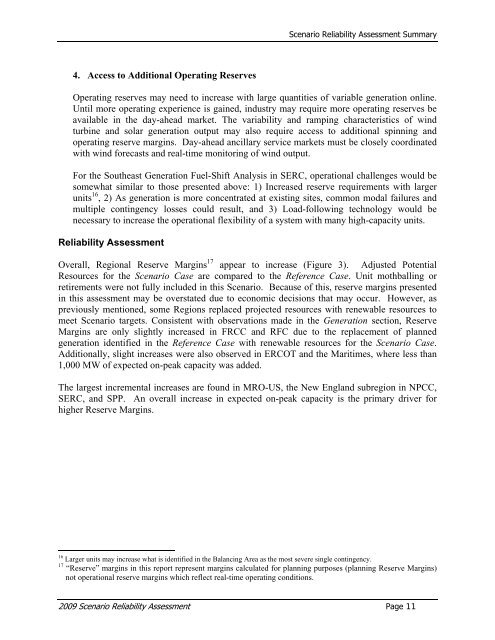2009 Scenario Reliability Assessment - NERC
2009 Scenario Reliability Assessment - NERC
2009 Scenario Reliability Assessment - NERC
- No tags were found...
Create successful ePaper yourself
Turn your PDF publications into a flip-book with our unique Google optimized e-Paper software.
<strong>Scenario</strong> <strong>Reliability</strong> <strong>Assessment</strong> Summary4. Access to Additional Operating ReservesOperating reserves may need to increase with large quantities of variable generation online.Until more operating experience is gained, industry may require more operating reserves beavailable in the day-ahead market. The variability and ramping characteristics of windturbine and solar generation output may also require access to additional spinning andoperating reserve margins. Day-ahead ancillary service markets must be closely coordinatedwith wind forecasts and real-time monitoring of wind output.For the Southeast Generation Fuel-Shift Analysis in SERC, operational challenges would besomewhat similar to those presented above: 1) Increased reserve requirements with largerunits 16 , 2) As generation is more concentrated at existing sites, common modal failures andmultiple contingency losses could result, and 3) Load-following technology would benecessary to increase the operational flexibility of a system with many high-capacity units.<strong>Reliability</strong> <strong>Assessment</strong>Overall, Regional Reserve Margins 17 appear to increase (Figure 3). Adjusted PotentialResources for the <strong>Scenario</strong> Case are compared to the Reference Case. Unit mothballing orretirements were not fully included in this <strong>Scenario</strong>. Because of this, reserve margins presentedin this assessment may be overstated due to economic decisions that may occur. However, aspreviously mentioned, some Regions replaced projected resources with renewable resources tomeet <strong>Scenario</strong> targets. Consistent with observations made in the Generation section, ReserveMargins are only slightly increased in FRCC and RFC due to the replacement of plannedgeneration identified in the Reference Case with renewable resources for the <strong>Scenario</strong> Case.Additionally, slight increases were also observed in ERCOT and the Maritimes, where less than1,000 MW of expected on-peak capacity was added.The largest incremental increases are found in MRO-US, the New England subregion in NPCC,SERC, and SPP. An overall increase in expected on-peak capacity is the primary driver forhigher Reserve Margins.16 Larger units may increase what is identified in the Balancing Area as the most severe single contingency.17 “Reserve” margins in this report represent margins calculated for planning purposes (planning Reserve Margins)not operational reserve margins which reflect real-time operating conditions.<strong>2009</strong> <strong>Scenario</strong> <strong>Reliability</strong> <strong>Assessment</strong> Page 11
















